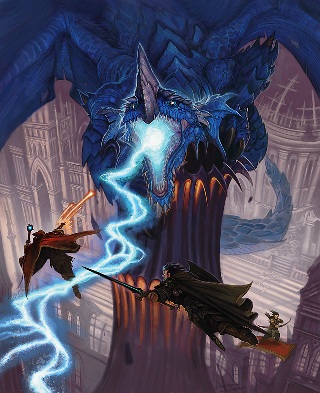
![]() D&D 4e lead designer Mike Mearls has come to the same conclusion many of us have since 4e was released in 2008: there’s far too many immediate actions and interruptions off-turn, creating massive game slowdown.
D&D 4e lead designer Mike Mearls has come to the same conclusion many of us have since 4e was released in 2008: there’s far too many immediate actions and interruptions off-turn, creating massive game slowdown.
Here are the pillars of redesigned immediate actions and similar triggers that Mike Mearls mentions:
In any case, I really don’t like the propagation of immediate actions. As a DM and player, I hate when the game’s brought to a screeching halt as someone stops to figure out if they can use an ability, what that ability might mean for the action, and if it’s even worth using at all. In theory, immediate actions are an interesting way to reward players for paying attention and focusing on teamwork, but in my experience they cause tremendous slowdown at the table.
I think pruning back such options and making them all strictly simpler would help a bit. I also think that their triggers should be made more obvious or more important in terms of the game. For instance, an ability that now triggers on a hit might instead trigger on a hit that drops a target. Dropping someone is a bigger event, it’s more important in the game, and it feels OK for it to demand the complexity and resolution time that immediate actions bring to the table.
In other words, it’s OK to make a rare or dramatically important event take longer. It’s irritating if every attack takes longer.
Wouldn’t these changes to immediate and similar actions make D&D combat smoother, faster and more exciting?
With these re-design concepts in mind, here are six ways you and your playgroup can immediately scale back off-turn actions in your game, including a couple originally from and inspired by This is My Game’s recent excellent article, The Future of D&D.
Talk with your playgroup about trying any or all of these right now at your gaming table, and agree on the ones you think would amp up your D&D game most:
Leonine 6: How to Scale Back Immediate Actions
1. Less. Set a per encounter limit of zero or one opportunity action and/or one immediate action per creature. And/or allow immediate actions only from specific sources, such as from magic items or monster traits only.
2. Static. Static or maximum damage. Decide on average, max, or a per-tier (i.e. 5 + 5 damage per tier) amount of damage only with triggered attacks, such as opportunity attacks.
3. Role. Role or class limitations on opportunity actions, such as allowing only defenders or defenders and strikers to make opportunity attacks.
4. Events. Choose or allow only the selection and use of immediate actions that trigger off only the most critical events or conditions only: i.e. bloodied, killed, crit and stunned.
5. Replace. Replace triggered actions that do not trigger off key events or conditions with bonus damage (i.e +5 damage per tier to basic attacks of PCs and monsters).
6. Remove. Do not use or do not allow any immediate actions or powers, triggers or traits that resemble them, possibly even including readied actions.
These ideas cover a wide range of approaches in combating the part of game slowdown that is due excessive immediate and similar triggered actions.
I thought about specifically addressing free actions that function just like immediate actions, but allowing those might be okay so long as some or most of the above design changes or house rules are applied to your games’ triggered actions. I like how they’re stronger, rarer and purposely break the rule of one immediate action per round. And if you’re going to reduce immediate action availability and frequency, perhaps it’s wise to leave this free action subset of triggered actions untouched.
Which of these six approaches do you like best? What are some of your own design suggestions to smartly and smoothly scale back off-turn actions, while still keeping them effective and exciting?
Related Reading
- Not So Immediate Actions
- Monster Complexity and Selection
- Faster Combat: Encounter Triggers Checklist
Honestly, I never really had a problem with immediate actions slowing down the combat. Sure, sometimes that happened, but the added dynamic of 4e’s strategcally chaotic combat usually offset that. As long as rules are consistent and fair, I don’t mind having several options that can change the combat scene (three actions, interrupt, opportunity attacks, action points, etc.).
MY problem (and this is simply my preference) with combat are the healers. I feel that the “healer” in the group is only there to prolong combat. That’s what they do, and they’re very good at it. If the system were tweaked so the heroes didn’t have to rely on healers, combat would be shorter, even though immediate interrupt actions prolonged individual actions. I don’t think those interrupt actions would bother anyone, as they simply make the shorter combat encounter more dynamic.
There’s definitely a lot of available healing in a party by design in 4e, with leader classes obviously paving the way. Still, in nearly every game I’ve been in, I don’t mind them doing their “job,” although they have plenty of immediate and similar actions that can also slow down play. That said, most heals seam to be straightforward to track and resolve in my experience.
What kind of tweaks to healing in 4e might you suggest, Tourq? How would these changes shorten combat, as you said? Do you mean that there’s so much healing that it’s hard to figure out who the winner will be fast enough?
In that sense, then yes, it’s similar to how immediate and triggered actions contribute to the overlong 60 minute combat average time in 4e.
[…] Six Ways to Scale Back Immediate Actions […]